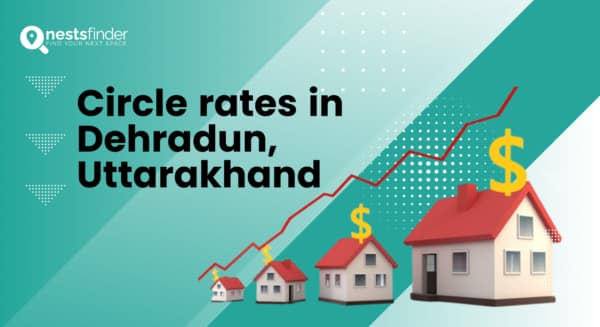Circle rates in Dehradun, Uttarakhand : A Comprehensive Guide
#realestate #property #circlerates #dehradun
- What are circle rates?
- Factors that affect circle rates in Dehradun
- Latest Circle Rate in Dehradun, Uttarakhand (2023)
- Conclusion
Circle rates : One of the cities in North India with the quickest growth is Dehradun. Dehradun, which is divided into seven major zones, is a desirable location for real estate investment due to its nice temperature, strong connectivity, and continuously growing infrastructure. However, it’s important to comprehend the idea of circle rates, which is important in real estate transactions, before purchasing or selling any property in Dehradun.
What are circle rates?
Circle rates, also known as collector rates or guideline rates, are the minimum prices set by the government for the sale or transfer of properties in a particular area. These rates are used as a reference point for calculating stamp duty and registration charges during property transactions.
Circle rates are determined by the local authorities or the state government and are revised periodically based on factors such as location, infrastructure development, demand, and market conditions. The purpose of circle rates is to prevent undervaluation of properties during transactions to avoid tax evasion and ensure fair property valuation.
Factors that affect circle rates in Dehradun
Several factors can influence circle rates in Dehradun. While the specific factors and their relative importance may vary over time, here are some common factors that can affect circle rates in the city:
- Location: The location of a property is a crucial factor in determining its circle rate. Areas that are closer to commercial centres, educational institutions, transportation hubs, or other amenities tend to have higher circle rates compared to remote or less-developed areas.
- Infrastructure: The availability and quality of infrastructure in an area play a significant role in determining circle rates. Factors such as well-maintained roads, water supply, electricity, public transportation, and connectivity to major areas can positively impact the circle rates.
- Demand and market conditions: The demand for properties in a particular area and the overall market conditions influence circle rates. If there is high demand and a competitive market, circle rates tend to be higher. Conversely, in areas with low demand or a sluggish market, circle rates may be lower.
- Development and urbanization: Areas undergoing rapid development and urbanization often experience an increase in circle rates. The introduction of new residential or commercial projects, infrastructural improvements, and overall growth in the area can lead to higher circle rates.
- Amenities and facilities: The presence of amenities and facilities such as parks, hospitals, shopping centers, schools, and recreational areas can impact circle rates. Areas with a higher concentration of such amenities are likely to have higher circle rates.
- Legal and regulatory changes: Changes in government policies, regulations, or taxation laws can affect circle rates. Revisions in land use policies, zoning regulations, or tax structures can influence circle rates in Dehradun.
It’s important to note that circle rates are determined by the local authorities or the state government, and they may periodically revise them based on these factors and other relevant considerations.
Latest Circle Rate in Dehradun, Uttarakhand (2023)
The most recent circle prices for the entire State have been released by the Uttarakhand State government. Although the average increase in circular prices is about 33%, some localities like Dehradun, Haridwar, and Nainital neighbourhoods have seen increases of over 100%.
Areas around the IT Park in Dehradun have undergone a 150 percent modification. The current circle pricing in this area is Rs 35,000 per sq m, up from Rs 14,000 per sq m. While the circular fee in Doiwala has increased from Rs 5,000 per sq m to Rs 8,000 per sq m, the rate between Mussoorie By-pass and Kuthalgate has more than doubled from Rs 24,000 per sq m to Rs 50,000 per sq m. Increasing circular rate is significant between 50% and 100% in Selakui’s industrial district. The circle fee near Rajpur Road, in contrast, increased marginally from Rs. 50,000 per sq. m. to Rs. 62,000 per sq. m.
The high jump in circle rates in certain areas of the State capital can be attributed to the under-construction Delhi-Dehradun Expressway and the Dehradun Airport extension. To know more about circle rates in dehradun you can visit nestsfinder website.
Conclusion
In conclusion, circle rates are the minimum prices set by the government for the sale or transfer of properties in a particular area. They serve as a reference point for calculating stamp duty and registration charges during property transactions. Circle rates are influenced by factors such as location, infrastructure, demand, market conditions, development, and amenities. However, for the latest circle rates in Dehradun, Uttarakhand in 2023, it is advisable to consult the local authorities or the revenue department for the most accurate and up-to-date information.




